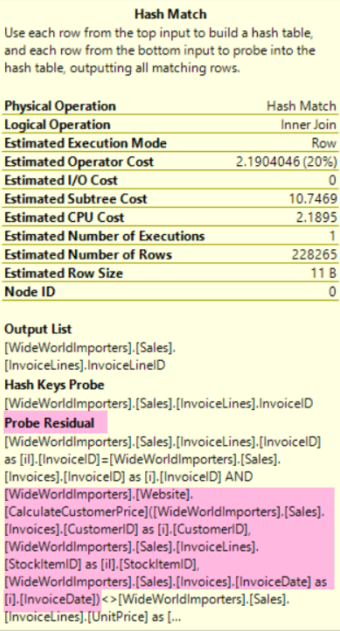How to Filter RPC_Completed Events in Extended Events: SQL Server Guide
The rpc_completed event in Extended Events is useful when troubleshooting SQL Server performance. It captures detailed information about Remote …
User defined functions are fairly simple to create in SQL Server, but figuring out exactly how they are being used can take a little time - even in a simple execution plan. This is because the functions can be tucked away into lots of different operators in the plan, even join operators.
The good news: once you learn what to look for, it’s not terribly complicated. There are some fancy terms involved, but the definitions are pretty simple.
Here’s a quick look at a function call hidden in a hash match operator, which is being used to implement an inner join.
This query uses the Microsoft WideWorldImporters sample database. The query calls the built in scalar user defined function, Website.CalculateCustomerPrice:
SELECT
il.InvoiceLineID
FROM Sales.Invoices AS i
JOIN Sales.InvoiceLines AS il
ON il.InvoiceID = i.InvoiceID
WHERE [Website].[CalculateCustomerPrice]
(
i.CustomerID,
il.StockItemID,
i.InvoiceDate
) <> il.UnitPrice;
GO
Here’s the query execution plan:

There’s not a lot of places for the function call to hide in this particular plan, right? No Compute Scalars to look into at all.
If we look at the properties of the Hash Match join, we can find the function call:

The description at the top of this tool tip is quite helpful when it comes to remembering how hash matches work: SQL Server is building a table in memory from the Sales.Invoices table. It’s then “probing” into it with items from the Sales.InvoicesLines table.
The “Hash Keys Probe” part of the tool tip tells us that it is looking for matches based on the InvoiceID column (our join column).
After we find matches based on the customer id, we have more work “left over”: that’s the “residual” bit.
For every row that matches, SQL Server is plugging values into the Website.CalculateCustomerPrice() function and comparing the result to the Unit price column, just like we asked for in the where clause.
In other words, this is happening for every row in Sales.InvoiceLines that has a matching row in Sales.Invoices.
Which is every single invoice & invoice line, as it turns out.
If you’re ever looking for an example of a query where collecting an actual execution plan dramatically slows down execution (observe effect), this is a good one. On instances I’ve tested, this query takes 14-18 seconds to run when no plan is collected, and about a minute longer when you enable actual plan collection.
When you’re looking at execution plans, it can be very tricky to spot user defined functions in the plan:
Copyright (c) 2025, Catalyze SQL, LLC; all rights reserved. Opinions expressed on this site are solely those of Kendra Little of Catalyze SQL, LLC. Content policy: Short excerpts of blog posts (3 sentences) may be republished, but longer excerpts and artwork cannot be shared without explicit permission.